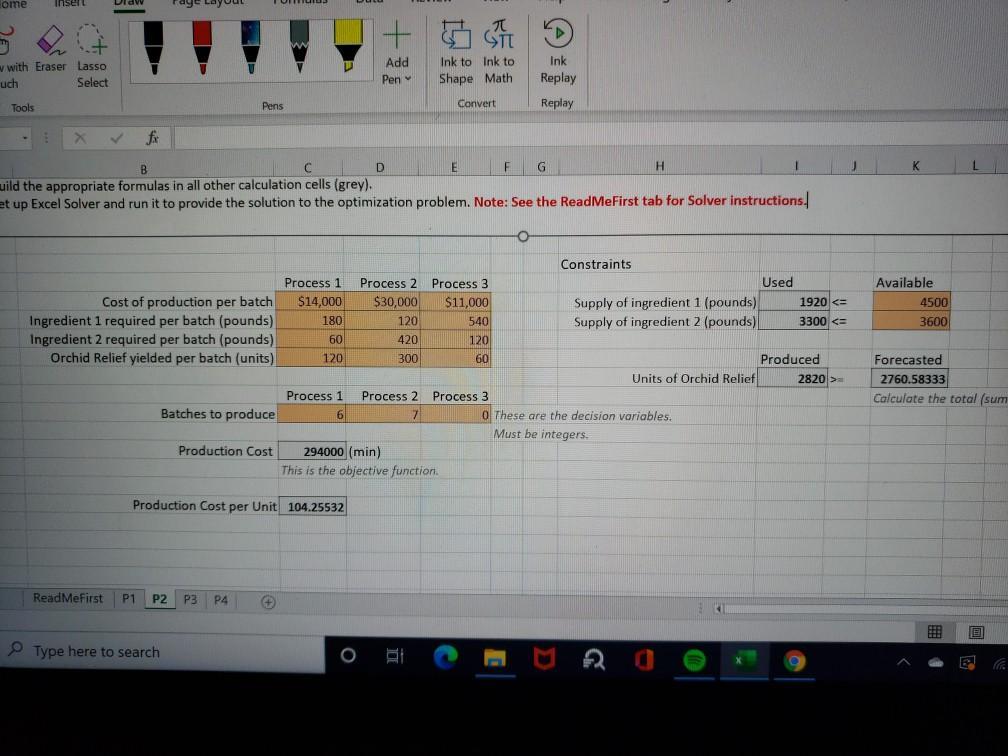Question
The second picture is the needed data from P2 that P3 says is needed P3. Consider a possible shortage of ingredients in the following week.
The second picture is the needed data from P2 that P3 says is needed
P3. Consider a possible shortage of ingredients in the following week. What would the optimized production process look like if Eli Orchid could only procure 4320 pounds of ingredient 1 and 1440 pounds of ingredient 2?
Follow these steps:
1. In the appropriate cells below type in the numbers obtained from the original optimal solution (no shortage) produced in P2.
2. In the Constraints table label each constraint in the original solution as binding or not-binding (select from the drop-down list).
3. Go back to P2, introduce the appropriate modifications that reflect the shortage situation described above and re-run the analysis.
4. Write down the new numbers (resulting from the shortage situation) in the appropriate cells below (Shortage column).
5. In the Constraints table (Shortage column) label each constraint in the new solution as binding or not-binding (select from the drop-down list).

Here is the needed info from P2. P2 is complete but data is needed to solve P3
P2 The new pharmaceutical product that the company wishes to introduce, Orchid Relief, uses two new ingredients. At this stage, Eli Orchid can procure limited amounts of each ingredient. The company has 4500 pounds of ingredient 1 and 3600 pounds of ingredient 2 available for this week. Eli Orchid can manufacture the new product using any of its three existing processes that have different capabilities. The production with each of the processes is done in batches (a batch typically represents one full run of a machine from when it starts a task until it finishes it. Therefore, a batch is an integer). Each batch of production by each of the processes uses different amounts of ingredients 1 and 2, and results in different numbers of units of Orchid Relief produced.
Please use the above description and the model below to help Eli Orchid determine how many batches to produce with each process in the least costly way, given the limited availability of the two ingredients. Also, the total production of Orchid Relief in units must be greater than or equal to the total forecasted demand (in units) for week 10 (see P1).
Specifically:
1. In cell K20 calculate the forecasted total demand for days 64-70 (based on P1).
2. Build the appropriate formulas in all other calculation cells (grey).
3. Set up Excel Solver and run it to provide the solution to the optimization problem.

AutoSave Off File H20 7 8 9 10 Select Draw with Eraser Lasso Touch Select 11 12 13 Home 14 15 16 17 18 19 20 21 22 23 24 25 26 27 89. Tools Insert B Draw Page Layout Number of batches Number of batches Number of batches ReadMeFirst 8 - P Process 1 Process 2 Process 3 Cost of production Unit cost Type here to search P1 P2 P3 P4 a EliOrchid 3618 P Botello Pens Formulas Data P2 P2 X fix A C D E F G H F J K L 1. In the appropriate cells below type in the numbers obtained from the original optimal solution (no shortage) produced in P2. 2. In the Constraints table label each constraint in the original solution as binding or not-binding (select from the drop-down list). 3. Go back to P2, introduce the appropriate modifications that reflect the shortage situation desctibed above and re-run the analysis. 4. Write down the new numbers (resulting from the shortage situation) in the appropriate cells below (Shortage column). 5. In the Constraints table (Shortage column) label each constraint in the new solution as binding or not-binding (select from the drop-down list). Shortage Shortage O + Add Pen Review View A Sit Ink to Ink to Shape Math Search Convert Help Ink Replay Replay Data Mining Supply of ingr. 1 Supply of ingr. 2 Units produced Constraints P2 Analytic Solver CHUR Shortage de Botello, Manuel BM M N 0 [E P Co 4
Step by Step Solution
3.48 Rating (178 Votes )
There are 3 Steps involved in it
Step: 1
P2 To determine the optimal number of batches to produce with each process in the least costly way given the constraints we can use linear programming Lets define the decision variables Let x1 be the ...
Get Instant Access to Expert-Tailored Solutions
See step-by-step solutions with expert insights and AI powered tools for academic success
Step: 2

Step: 3

Ace Your Homework with AI
Get the answers you need in no time with our AI-driven, step-by-step assistance
Get Started


